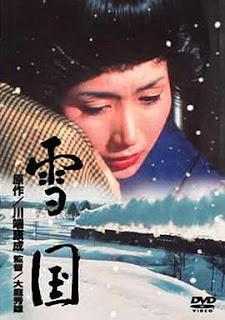29. Pún-lâi sī chhī niû-á ê pâng-keng
Chiàⁿ-chhiú pêng sī khàm seh ê hûiⁿ, tò-pêng iân keh-keng ê chhù-piah sī chi̍t-pâi khī-á chhiū. Chhù ê thâu-chêng ká-ná sī hoe-hûiⁿ, chiàⁿ tiong-ng ū chi̍t-ê sè-sè ê liân-hoe tî, tî tiong ê peng í-keng ko͘ tī tî-á-piⁿ, tî lāi âng lí-hî siû lâi siû khì. Chhù hām khī-á chhiū-kut kāng-khoán, àu-kó͘ kah bē-kóng-lih. Chek-seh ê chhù-téng, chhâ-pang í-keng àu, gîm-chîⁿ mā oai-ko chhi̍h-chhoa̍h.
Ji̍p-mûi kàu thô͘-keng (土間, ji̍p mûi bô pho͘ tē-pán ê só͘-chāi), chēng koh kôaⁿ, sáⁿ mā bô khòaⁿ-e, Shimamura tō hō͘ chhōa khì peh lâu-thui. Che sī chin-chiàⁿ ê thui, téng-koân ê pâng-keng mā chin-chiàⁿ sī lâu-kông-téng.
"Chia pún-lâi sī chhī niû-á ê pâng-keng. Lí ū kiaⁿ tio̍h bô?"
"Chùi bâng-bâng tún lâi, peh che thui ka-chài m̄-bat poa̍h lo̍h."
"Bat poa̍h lo̍h! M̄-koh nā lim siuⁿ chē, góa chóng-sī kiu ji̍p lâu-kha ê phōe-lô͘, sûi tō khùn khì." Komako án-ne kóng, ná kā chhiú chhun ji̍p phōe-lô͘ ê phōe lih thàm chi̍t-ē, tō koh khiā khí-lâi, khì lâu-kha the̍h hóe-thòaⁿ.
Shimamura sàu chi̍t-liàn khòaⁿ che kî-koài ê pâng-keng. Kan-ta ǹg lâm khui chi̍t-ê kē-kē ê thang-á-mûi, sè-keh thoah-mûi ê chóa sī sin kô͘ ê, ji̍t-thâu chiò tio̍h kuiⁿ iāⁿ-iāⁿ. Piah-téng mā iōng-sim tah móa soan-chóa, hō͘ lâng kám-kak ná-chhiūⁿ tī kū chóa-siuⁿ-á lāi-té. M̄-koh, thâu-khak téng ê chhù-kòa khòaⁿ hiān-hiān, óa thang-á-mûi ê ūi chhù chin kē, àm-àm sàm-sàm, ū chi̍t-chióng chheⁿ-chhìn ê khì-hun. Siūⁿ tio̍h piah ê hit-pêng m̄-chai sī sáⁿ khoán, tō ē kám-kak che chhù ká-ná tiàu tī pòaⁿ khong-tiong, hō͘ lâng sim bē an-tēng. M̄-koh, piah hām tatami sui-jiân sī kū, khiok lóng chin chheng-khì.
Khó-lêng ná niû-á án-ne, Komako thàu-bêng ê hûn-su mā tī chia seng-oa̍h lah: i án-ne siūⁿ.
Phōe-lô͘ téng kòa chi̍t-niá hām seh-khò͘ kāng-khoán ti̍t-chōa hoe-chháu ê mî-phōe. Saⁿ-á-kūi sui-jiân kū, khiok sī ti̍t-bûn ba̍t-chit ê tông-bo̍k, káⁿ sī Komako tī Tokyo seng-oa̍h só͘ lâu lo̍h-lâi ê. Che hām chho͘-phè-phè ê se-chng-tâi bô sù-phòe. Âng-chu-chhat ê chiam-sòaⁿ-a̍p iáu ē siám-kuiⁿ, ū chhia-hoa ê khoán-sè. Tèng tī piah-téng chi̍t-chàn chi̍t-chàn ê chhâ-pang, káⁿ sī chheh-kè, téng-bīn kòa chi̍t-tè po̍h-po̍h mô͘ ê pò͘-lî.
--
29. 本來是飼娘仔 ê 房間
正手爿是崁雪 ê hûiⁿ, 倒爿沿隔間 ê 厝壁是一排柿仔樹. 厝 ê 頭前 ká-ná 是花 hûiⁿ, 正中央有一个細細 ê 蓮花池, 池中 ê 冰已經 ko͘ tī 池仔邊, 池內紅鯉魚泅來泅去. 厝和柿仔樹骨仝款, 漚古 kah 袂講 lih. 積雪 ê 厝頂, 柴枋已經漚, 砛簷 mā 歪膏揤斜.
入 mûi 到 thô͘-keng (土間, 入 mûi 無鋪地板 ê 所在), 靜 koh 寒, 啥 mā 無看 e, Shimamura tō 予 chhōa 去 peh 樓梯. 這是真正 ê 梯, 頂懸 ê 房間 mā 真正是樓栱頂.
"遮本來是飼娘仔 ê 房間. 你有驚著無?"
"醉茫茫 tún 來, peh 這梯佳哉 m̄-bat 跋落."
"Bat 跋落! 毋過若啉 siuⁿ 濟, 我總是勼入樓跤 ê 被爐, 隨 tō 睏去." Komako án-ne 講, ná kā 手伸入被爐 ê 被 lih 探一下, tō koh 徛起來, 去樓跤提火炭.
Shimamura 掃一輾看這奇怪 ê 房間. 干焦 ǹg 南開一个低低 ê 窗仔 mûi, 細格挩 mûi ê 紙是新糊 ê, 日頭照著 kuiⁿ 焱焱. 壁頂 mā 用心貼滿宣紙, 予人感覺 ná 像 tī 舊紙箱仔內底. 毋過, 頭殼頂 ê 厝蓋看現現, 倚窗仔 mûi ê 位厝真低, 暗暗毿毿, 有一種生凊 ê 氣氛. 想著壁 ê 彼爿毋知是啥款, tō 會感覺這厝 ká-ná 吊 tī 半空中, 予人心袂安定. 毋過, 壁和 tatami 雖然是舊, 卻攏真清氣.
可能 ná 娘仔 án-ne, Komako 透明 ê 魂軀 mā tī 遮生活 lah: 伊 án-ne 想.
被爐頂掛一領和雪褲仝款直逝花草 ê 棉被. 衫仔櫃雖然舊, 卻是直紋密質 ê 桐木, káⁿ 是 Komako tī Tokyo 生活所留落來 ê. 這和粗 phè-phè ê 梳妝台無四配. 紅朱漆 ê 針線盒猶會閃 kuiⁿ, 有奢華 ê 款勢. 釘 tī 壁頂一層一層 ê 柴枋, káⁿ 是冊架, 頂面掛一塊薄薄毛 ê 布簾.
--
29.
To the right was a small field, and to the left persimmon trees stood along the wall that marked off the neighboring plot. There seemed to be a flower garden in front of the house, and red carp were swimming in the little lotus pond. The ice had been broken away and lay piled along the bank. The house was old and decayed, like the pitted trunk of a persimmon. There were patches of snow on the roof, the rafters of which sagged to draw a wavy line at the eaves.
The air in the earthen-floored hallway was still and cold. Shimamura was led up a ladder before his eyes had become accustomed to the darkness. It was a ladder in the truest sense of the word, and the room at the top was an attic.
"This is the room the silkworms used to live in. Are you surprised?"
" You're lucky you've never fallen downstairs, drinking the way you do."
"I have. But generally when I've had too much to drink 1 crawl into the kotatsu downstairs and go off to sleep." She pushed her hand tentatively into the kotatsu, then went below for charcoal. Shimamura looked around at the curious room. Although there was but one low window, opening to the south, the freshly changed paper on the door turned off the rays of the sun brightly. The walls had been industriously pasted over with rice paper, so that the effect was rather like the inside of an old-fashioned paper box; but overhead was only the bare roof sloping down toward the window, as if a dark loneliness had settled itself over the room. Wondering what might be on the other side of the wall, Shimamura had the uneasy feeling that he was suspended in a void. But the walls and the floor, for all their shabbiness, were spotlessly clean.
For a moment he was taken with the fancy that the light must pass through Komako, living in the silkworms' room, as it passed through the translucent silkworms.
The kotatsu was covered with a quilt of the same rough, striped cotton material as the standard "mountain trousers . " The chest of drawers was old, but the grain of the wood was fine and straight-perhaps it was a relic of Komako's years in Tokyo. It was badly paired with a cheap dresser, while the vennilion sewing-box gave off the luxurious glow of good lacquer. The boxes stacked along the wall behind a thin woolen curtain apparently served as bookshelves.
--


No comments:
Post a Comment